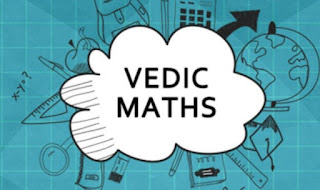VEDIC MATHS-35
VEDIC MATHS
By OMKAR TENDOLKAR
This is post number 35 from the series of "Vedic maths" blogs. Here in this blog we will learn about "Example of Base method of multiplication when base is not power of 10".
The base method of multiplication is having large contribution in Vedic Mathematics. The name Base method is given by Vedic Mathematics in western countries.
Actual Sanskrit sutra as given by Swamiji to define this system is:
‘Nikhilam Navatascaramam Dasatah.’ It means ‘all from 9 and the last from 10.’
For all practical purposes, we shall be calling the system elaborated in this chapter as the 'Nikhilam method' or simply the ‘Base Method'.
This method is used to multiply numbers. It is helpful in many cases where traditional multiplication takes a long time to calculate the answer. Let us take the case of multiplying the number 9999999 by 9999991.
If you go by the traditional method it will take a long time to multiply the numbers and calculate the product. However with the technique described in the Base Method one can find the answer in less than 5 seconds. The study of the Base Method is important to understand the other formulae of Vedic Mathematics.
There is a corollary of the Base Method which is called the Yavadunam Rule. This sutra is used in squaring numbers that we will discussed in the next post of our blogs.
In the last blog, we have seen the
different situations in which the base method was used. We took numbers above
and below the base, we took numbers far away from the base and so on. All the while
we were taking only powers of 10, namely 10, 100, 1000, etc. as bases, but in
this section we will take numbers like 40, 50, 600, etc. as bases.
In the problems that will follow, we will have two bases — an actual base and a working base. The actual base will be the normal power of ten. The working base will be obtained by dividing or multiplying the actual base by a suitable number. Hence, our actual bases will be numbers like 10, 100, 1000, etc. and our working bases will be numbers like 50 (obtained by dividing 100 by 2) or 30(obtained by multiplying 10 by 3), 250 (obtained by dividing 1000 by 4).
Actual Bases: 10,
100, 1000, etc.
Working bases: 40, 60, 500, 250, etc.
(1) Multiply 48
by 48
4 8 -2
Actual base = 100
Working base=100/2 = 50
- In this case the actual base is 100 (therefore RHS will be a two-digit answer). Now, since both the numbers are close to 50 we have taken 50 as the working base and all other calculations are done with respect to 50.
- The difference of 48 and 50 is -2 and so we have taken the difference as -2 in both the multiplicand and the multiplier.
- We have the base and the difference.
- The vertical multiplication of -2 by -2 gives 4. We convert it to a two-digit answer and write it as 04.
- The cross answer of 48 - 2 is written as 46 and put on the LHS. The answer is 4604.
- Now, since 50 (the working base) is obtained by dividing 100 (the actual base) by 2, we divide the LHS 46 by 2 and get 23 as the answer on LHS. The RHS remains the same.
(In this system, the RHS always remains the same.)
2) Multiply 27 by 28
2 7 +7
Actual base: 100
Working base: 100/5 = 20
The answer obtained through the base method is 3556. But, since 100 is divided by 5 to get 20, we divide the answer on the LHS, namely, 35 by 5 to get 7.
The final answer is:
27 * 28 = 756.
(Q) Multiply 59 by 58
5 9 -1
Actual base: 10
Working base: 10 × 6 = 60
The actual base is 10 and thus RHS will be a single digit answer. Since the actual base is multiplied by 6 to get the working base, the answer on the LHS is also multiplied by 6 (57 × 6) to get 342.
The final answer is :
59 * 58 = 3422.
- 45*45=2025
- 245*248=60760
- 395*396=156420
1. 57 * 59
2. 123 * 117
3. 1019 * 1025
You may answer this in comment box. You may ask your any query or doubt in comment box. I will try to resolve as early as possible.
In next blog we will discuss about "Concept of Base method for Square".
We will meet very soon through our next blog. Till that stay connected, stay healthy and stay safe.
Thanks
for giving your valuable time.
Good day😊.


Comments
Post a Comment